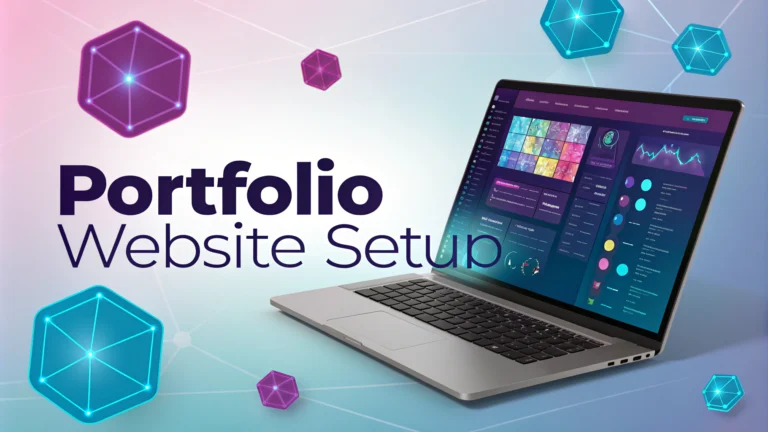A well-designed portfolio website helps showcase your work and attract potential clients.
Your website’s logo serves as the visual foundation of your brand identity and appears on every page.
Essential Elements of Portfolio Website Logo Design
- Simple shapes and clean lines that scale well across devices
- Color schemes that match your portfolio’s overall design
- Typography that reflects your professional style
- Versatile design that works in both color and black & white
Logo Placement Options
- Top left corner (traditional and most recognized spot)
- Centered header position (modern approach)
- Custom placement for creative portfolios
Technical Specifications
| Format | Size | Use Case |
|---|---|---|
| SVG | Scalable | Primary website logo |
| PNG | 250px minimum | Favicon, mobile display |
DIY Logo Design Tools
- Canva – User-friendly interface with templates
- Figma – Professional design tool with free tier
- Adobe Illustrator – Industry standard for vector graphics
Professional Logo Design Services
Quick Tips for Logo Success
- Test your logo at different sizes before finalizing
- Create variations for dark and light backgrounds
- Save multiple file formats for different uses
- Register your logo design for trademark protection if needed
Remember to maintain consistent branding across all platforms by using the same logo variations.
Common Logo Design Mistakes to Avoid
- Using too many colors or fonts
- Creating overly complex designs
- Following short-lived trends
- Copying other brands’ designs
Consider hiring a professional designer if you need a custom solution that sets you apart from competitors.
Logo Design Process
Research Phase
- Study competitors’ logos in your industry
- Create mood boards for inspiration
- Define your brand personality and values
- Identify target audience preferences
Development Timeline
- Initial concept sketches (2-3 days)
- Digital mockups (3-5 days)
- Refinement and iterations (1 week)
- Final file preparation (2-3 days)
Logo Implementation
Brand Guidelines
- Document logo spacing requirements
- Specify minimum size restrictions
- Define color codes (RGB, CMYK, HEX)
- List approved and prohibited uses
Integration Checklist
- Website header and footer
- Social media profiles
- Marketing materials
- Business documents
Conclusion
A well-designed logo is crucial for portfolio website success. Whether choosing DIY tools or professional services, focus on creating a timeless design that represents your brand effectively. Regular updates and consistent implementation across all platforms will maintain your professional image and strengthen brand recognition.
Invest time in proper file organization and documentation to ensure your logo serves its purpose across various applications. Remember that successful logo design balances creativity with functionality while maintaining professional standards.
FAQs
- What are the essential components I need for a professional portfolio website?
A portfolio website typically needs a homepage, about section, portfolio/work gallery, contact information, responsive design, and clear navigation. Include a blog section if relevant to your field. - How important is the choice of logo design for my portfolio website?
A logo is crucial as it represents your personal brand identity. It should be simple, memorable, and work well across different sizes and platforms, from website headers to social media profiles. - What file formats should I save my logo in for web use?
Save your logo in multiple formats: SVG for scalability, PNG for transparency needs, and JPEG for standard use. Also create a favicon version (.ico) for browser tabs. - Which website builders are best for creating portfolio websites?
Popular and reliable options include WordPress, Squarespace, Wix, and Adobe Portfolio. Each platform offers different features and levels of customization for portfolio presentation. - How can I ensure my portfolio website is mobile-responsive?
Use responsive design frameworks, test on multiple devices, ensure images are optimized, implement flexible grids, and use mobile-friendly navigation menus. - What’s the recommended logo size for a portfolio website?
Header logos should typically be 250-400 pixels wide, while ensuring the file is high-resolution (at least 72 dpi for web). Create multiple sizes for different sections of your site. - How should I optimize my portfolio website for search engines?
Use relevant keywords, optimize images with alt tags, create quality meta descriptions, ensure fast loading times, and implement proper heading hierarchy and URL structure. - What color schemes work best for portfolio websites and logos?
Choose 2-3 main colors that reflect your brand personality and ensure good contrast. Keep consistency across your website and logo design while maintaining readability. - Should I include my logo design process in my portfolio?
Yes, showcasing your logo design process demonstrates your professional approach and helps clients understand the value of your work. Include sketches, iterations, and final implementations. - How often should I update my portfolio website and logo?
Review and update your portfolio content quarterly, while logo design should be evaluated every 2-3 years to ensure it remains current with design trends and your brand evolution.







